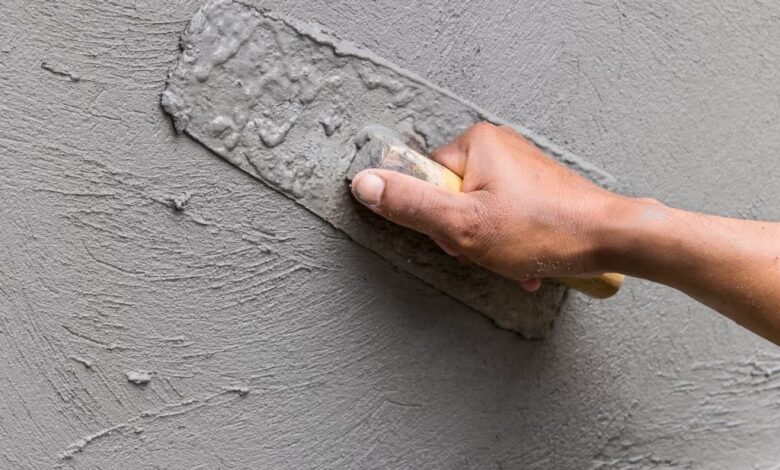Best cement for plaster in India

When it comes to construction projects, choosing the right materials is crucial for ensuring the durability and aesthetics of the structure. Among the essential components is the choice of the best cement in India for plaster, a critical step in construction that requires careful consideration. In India’s dynamic construction industry, builders and developers seek the best cement for plaster and plastering work to achieve optimal project results. In this comprehensive guide, we’ll look into the key aspects of selecting the best cement for plaster in India, exploring various considerations, design implications, and best practices for flawless plastering work.
Understanding the Importance of Cement in Plaster Design:
Cement, a fundamental building material, plays a pivotal role in the cement plastering design process. Cement plastering design is not just a cosmetic enhancement but serves as a protective layer for the underlying structure, safeguarding it against weathering, moisture, and other environmental factors. The right choice of cement for plaster is vital in ensuring the longevity, strength, and overall performance of the plastered surface.
Factors to Consider When Choosing the Best Cement for Plaster:
Type of Cement:
The type of cement used in plastering work significantly influences the outcome. Common types include Ordinary Portland Cement (OPC), Portland Pozzolana Cement (PPC), and Portland Slag Cement (PSC). Each type has distinct properties, and the selection should align with the specific requirements of the project to be considered the best cement for plaster in India.
- OPC: Known for its high compressive strength, OPC is suitable for general construction purposes and plastering work. It is ideal for areas where the structure requires maximum strength and load-bearing capacity.
- PPC: Combining Portland cement with pozzolanic materials, PPC enhances workability, durability, and plaster design. It is an eco-friendly choice and is suitable for plastering in areas exposed to water and dampness.
- PSC: Incorporating granulated blast furnace slag, PSC offers improved resistance to chemical attacks and is particularly beneficial in coastal regions where structures face challenges from saltwater.
Fineness and Setting Time:
The fineness of cement particles and setting time are critical factors influencing the workability and curing time of plaster. Finer particles contribute to better bonding and smoother finishes. Additionally, understanding the setting time is essential to plan the plastering work efficiently. These factors have a role to play in determining something as the best cement for plastering in India.
Admixtures:
Incorporating admixtures can enhance the properties of the plaster mix. These additives may include plasticizers, accelerators, or retarders, depending on the specific requirements of the project. Admixtures can improve workability, reduce water demand, and enhance the overall performance of the plaster.
Curing Process:
Proper curing is indispensable for achieving the desired strength and durability of plaster. The curing process involves maintaining adequate moisture levels for an extended period, preventing cracks and ensuring the optimal hardening of the plaster.
Best Practices for Cement Plastering Design:
Surface Preparation:
Before applying plaster, thorough surface preparation is essential. The substrate should be clean, free from dust, and adequately cured. A damp surface helps in better adhesion of the plaster mix.
Proportionate Mixing:
Achieving the right mix proportion is crucial for the success of plastering work and cement plastering design. Follow the recommended water-cement ratio and mix the components thoroughly to avoid lumps and inconsistencies.
Application Techniques:
The method of applying plaster significantly influences the final finish. Traditional techniques like trowel application and spray plastering offer distinct advantages, and the choice depends on the project’s requirements and the desired finish.
Layer Thickness:
Understanding the ideal thickness of each plastering layer is vital. Too thin a layer may compromise strength, while excessive thickness can lead to cracking. Following the recommended thickness ensures a balanced and durable plaster.
Versatility of Portland Pozzolana Cement (PPC)
PPC has gained popularity in the Indian construction industry due to its versatility and enhanced durability. Builders find it particularly beneficial for plastering work and plaster design in diverse environmental conditions, making it a top choice for projects across the country.
Optimising Strength with Ordinary Portland Cement (OPC)
In regions where high compressive strength is paramount, such as in multi-story constructions, OPC remains a preferred choice for plastering. Its robust nature provides the necessary structural integrity, ensuring the longevity of the plastered surfaces.
Addressing Coastal Challenges with Portland Slag Cement (PSC)
Coastal regions face unique challenges, including saltwater exposure that can impact the integrity of plastered surfaces. Builders in such areas often opt for PSC due to its resistance to chemical attacks, making it an ideal choice for durable plaster design.
Eco-Friendly Construction with Pozzolanic Materials
The increasing emphasis on sustainable construction practices has led to a surge in the use of PPC, which incorporates pozzolanic materials, making it the best cement for plaster in India when it comes to this. This not only enhances the green quotient of a project but also contributes to the long-term durability of the plaster.
Conclusion:
Choosing the best cement for plaster in India involves a thoughtful analysis of various factors, including the type of cement, surface preparation, application techniques, and curing processes. Builders and developers must align their choices with the project’s specific requirements to ensure the plastered surfaces’ longevity, strength, and aesthetic appeal. With a plethora of cement options available, understanding the nuances of each type empowers construction professionals to make informed decisions, resulting in successful and enduring plastering work.
As the construction landscape continues to evolve, staying abreast of the latest advancements in cement technology and implementing best practices in plastering design will be paramount for achieving excellence in every project. The journey to finding the best cement for plaster in India is not just about selecting a material; it’s about shaping the future of construction with durability, innovation, and a commitment to quality plastering work.



